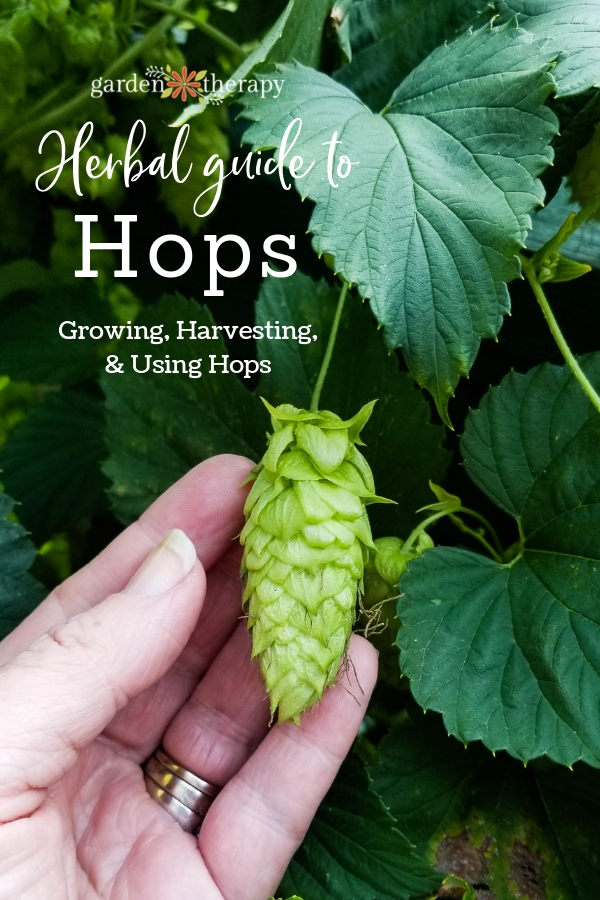No garden should be without a hops plant. And not just because it makes great beer! There’s so much more to know about hops as a wonderful ornamental garden plant and powerful healing herb. This guide to hops will show you why you should absolutely grow it as an ornamental, how to harvest the strobiles, and how to dry and use hops for insomnia and anxiety.
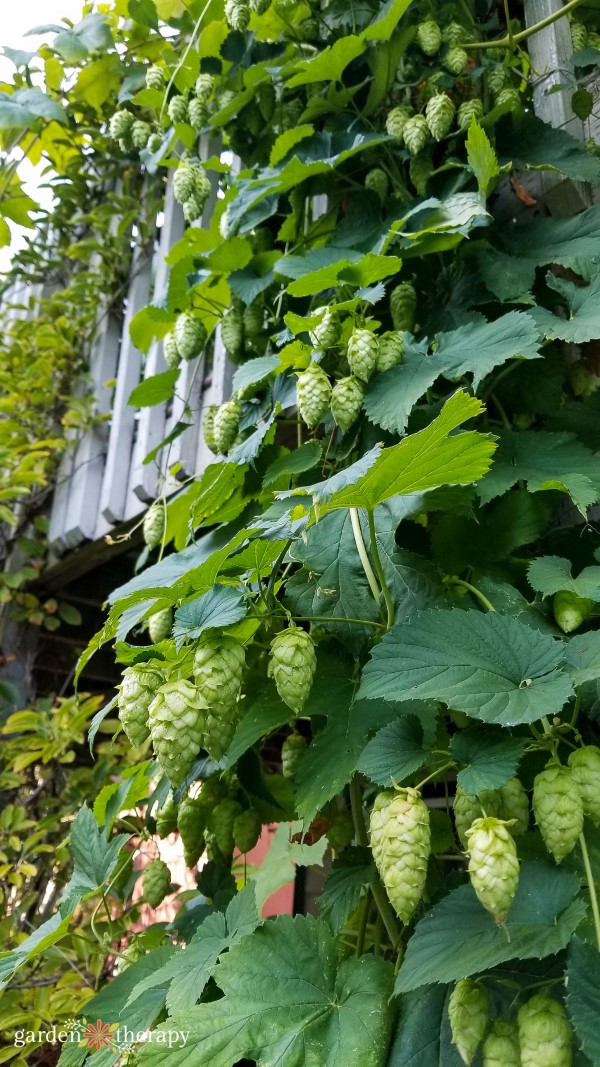
Over ten years ago, I went on a garden tour where the homeowner had a beautiful arbour covered in gorgeous golden flowers that looked like paper pinecones. I was drawn to this arbour, and as I stood underneath it, I was able to breathe in the aroma that can be described as none other than hoppy. It’s not a sweet or floral smell, and yet I was immediately relaxed.
The combination of the plant’s prolificness, the beauty of the arbour covered in flowers and green leaves, and the heady, bitter smell of hops was intoxicating. It was at that moment that I knew I wanted hops in my garden, too.
I didn’t grow it to make my own beer but rather for the beauty it provides as an ornamental. Little did I know I was growing a powerful, unsung hero. It can cover a whole trellis in one summer, make beautiful dried flower arrangements, put me to sleep, and even decorate a wreath.
So really, what can’t hops do? Let’s dive into everything you need to know about hops.
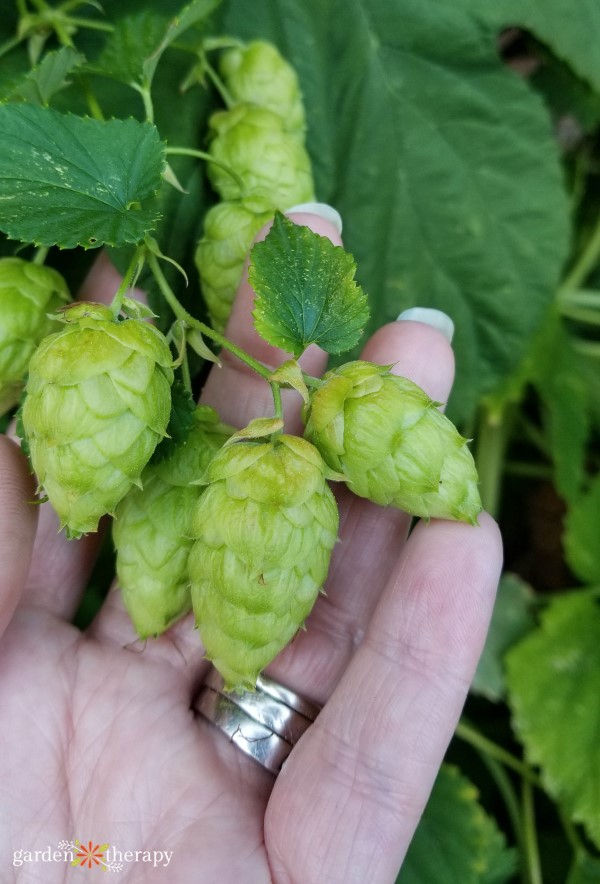

Lori’s Green Blessings
This article was reviewed by herbalist Lori Snyder. This is not to be used as personal medical advice; always consult your health care professional for individual concerns.
Here is what Lori had to say:
Humulus lupulus is native to North America, Europe, and Asia. Various nations like the Cherokee, Delaware, Dakota, and Ojibwa accessed hops for their analgesic properties, used as a gynecological aid, a sedative, gastrointestinal pains, toothache, and earache remedy. The Algonquin peoples of Quebec used to make bread and cake hops! In Traditional Chinese Medicine, hops were used for insomnia, restlessness, indigestion, intestinal cramps, and lack of appetite. By soothing the smooth muscle of the gastrointestinal tract, hops affect the “second brain” known as the enteric nervous system, relaxing the central nervous system. Hops have a mild influence on estrogen and may cause menstrual irregularities.
What Do Hops Look Like?
Hops have long leaves and the flowers resemble light green pinecones. The flowers dry to a warm golden colour and hold their shape well. The bines stay intact when cut and it makes them perfect to wind around a grapevine wreath for festive fall decoration.
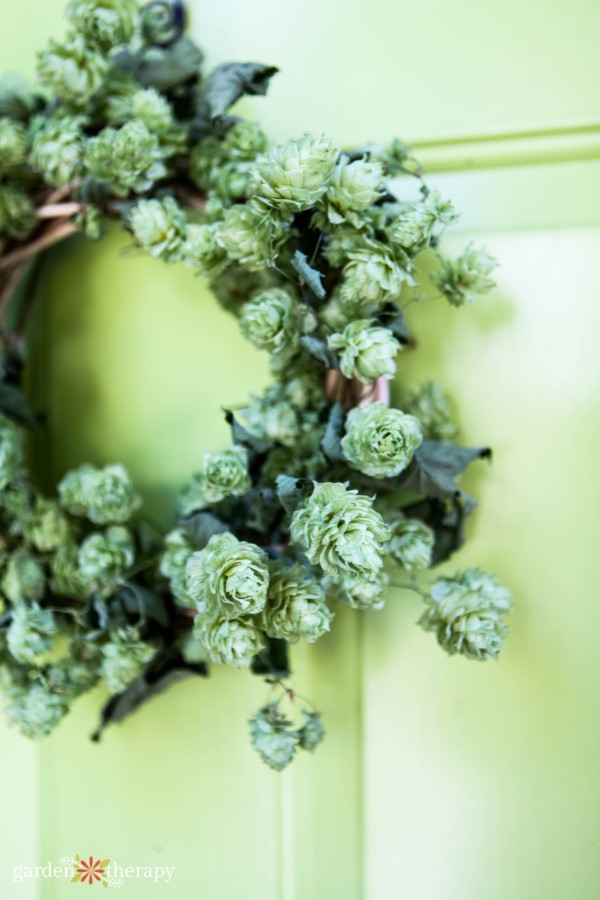

Hops Flower Benefits
Because of the sheer volume of hops that the bines produce in a season, I have dried many flowers and tested out many recipes.
Helps Reduce Insomnia
My favourite is to tuck them into sachets in my pillow to help aid insomnia. In fact, hops are one of my top recommendations for herbs to help you sleep!
This practice dates all the way back to 9th century Europe when the hops plant first became a useful tool for herbal medicine. Field workers who were working with hops plants to grow beer would often fall asleep on the job compared to other workers. People connected the dots and started using the sedative effects to help with sleep and anxiety disorders.
You can read more about fascinating herbal histories from around the world here.
Reduces Menopausal Symptoms
The plant also has estrogen-like characteristics as it contains phytoestrogens. These share many properties similar to human estrogen, meaning hops can help treat menopausal symptoms.
Helps with Anxiety
Like many people, I’ve struggled with anxiety and insomnia. Daily stresses, money troubles, family trauma, and chronic pain have done their part to make it hard for me to sleep some nights, which can lead to anxiety.
I work hard to maintain healthy sleep habits because sleep is so important for the body to heal. Including hops in a variety of ways has been really good for me, but please keep in mind that hops’ strong sedative properties mean that they may not be the right herb to use for people with depression.
However, if you’re looking for something to help you slow down and rest, hops are the way to go. Especially when you grow this prolific plant in your own garden.
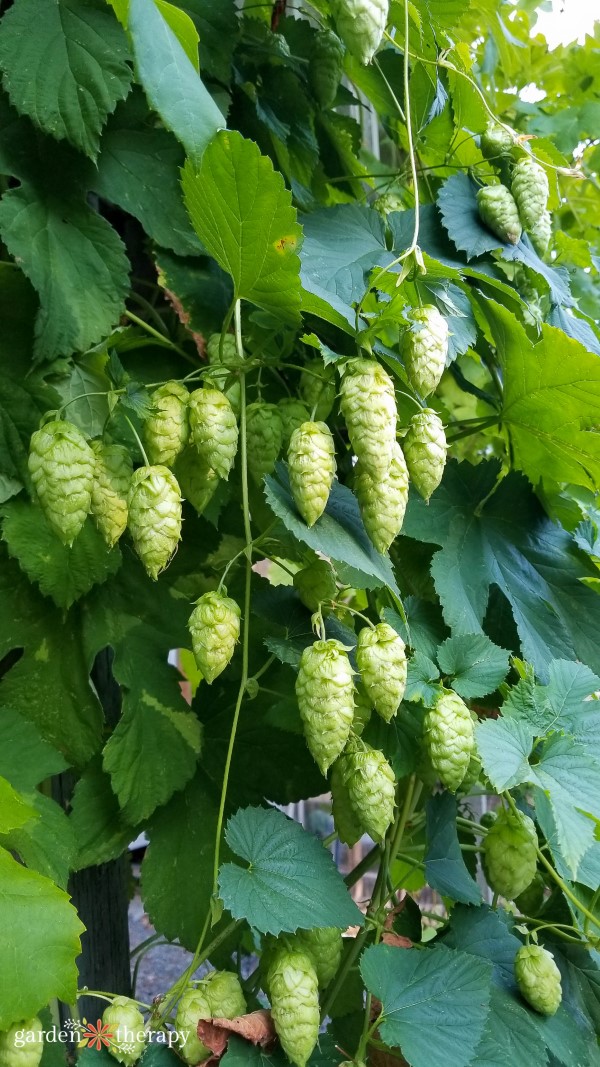

Growing Hops at Home
Hops (Humulus lupulus) can reach staggering heights in a short growing season. They grow on climbing bines (not vines) where the stems wrap-around support structures (like pole beans) rather than attaching like a vine by tendrils or suckers (like peas).
Hops flowers will always twist in a clockwise direction, even if you try your best to get them to go another way. So let them do their own thing!
Build a tall trellis or arbour to let them twist and climb and you will notice how they fill it up quickly. In fact, they can grow up to 12 inches a day! Talk about a lot of hops.


The plants are hardy in Zones 3-8. They like deep, well-draining soil in full sun. Hops can be started from seed, but they can grow into male or female plants.
Female plants produce the strobiles, or the leaf bracts surrounding small flowers. AKA, the hops flower cones you see pictured above and the ones used to make beer. Instead, take a rhizome division from an established female plant, you don’t need a male plant for flowering.
This is a great video on how to grow hops in your home garden.


Drying and Harvesting Hops Flowers
Hops are in the same family as cannabis and hemp, so if you have grown cannabis before, you may find the hops plant has some similarities. The best time for harvesting hops is when they have ripened on the bines in the late summer. Do not pick them early, or they will not ripen.
They are ready to pick when they are papery, springy to the touch, and a bit sticky. They should smell distinctively hoppy when they are ready. Check them by smelling first, then gently squeezing one between your index finger and thumb to test how they feel.
You can pick ripe hops one by one or remove bines from the plant. Unless you are making beer, you should have plenty to leave in the garden in the fall and winter as well. I only take a small fraction of the plant to use and leave the rest to overwinter.
I hang my hops to dry in my studio and it provides decoration, aroma, and a perfect spot to dry them. You can also use a food dehydrator or oven-dry hops if you are in a hurry. More hop drying methods can be found here.
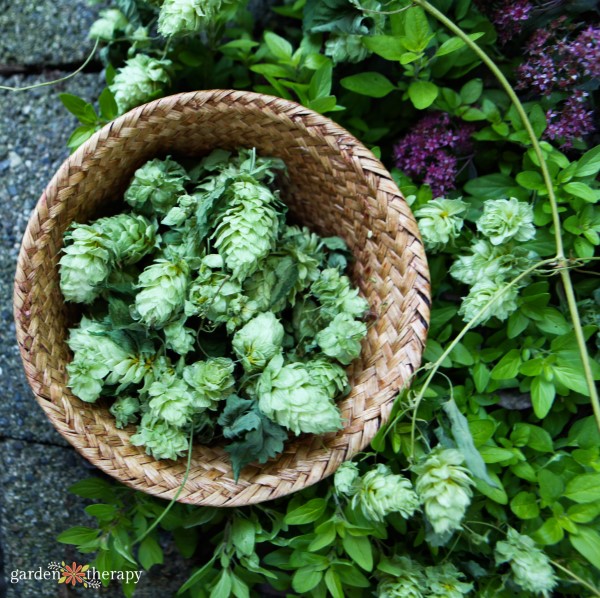

Using Hops Plant as an Herb
Beyond beer, what are hops used for? Since it’s such an uncommon herb to grow in the garden, it’s no wonder I often get this question whenever someone sees my hops plant. And before you ask, NO it does not have the same smoking effect as its closely related family member, cannabis.
The herbal part of the plant is the strobiles that hold the flowers and pollen that in turn contain lupulin, bitters, resin, and oil. The herb is used for calming: reducing anxiety, encouraging sleep, taming an upset tummy, and even helping to temper sexual desire. Keep this in mind when you are planning to use hops as an herb. If you have excess energy that could use balancing out, hops could be very helpful.
While you technically can eat hops, I wouldn’t recommend it due to its taste. The best way to enjoy the herbal benefits of hops is with tea.
Hops are quite bitter as a tea, and the flavour can be hard for some people to tolerate. However, their bitterness is actually a plus when it comes to digestion. Bitter herbs help to stimulate digestion, so you can use them to make homemade bitters and take ½ teaspoons before meals.
The hops plant is a wonderful herb to use in natural skincare recipes as well. Try infusing oils with hops to use in soap and healing salves. Hops’ calming effect works on the skin as well to reduce inflammation and help with both wrinkles and acne.
For anxiety and insomnia, you can try taking a hops tincture or making a dream pillow to fall asleep with at night.
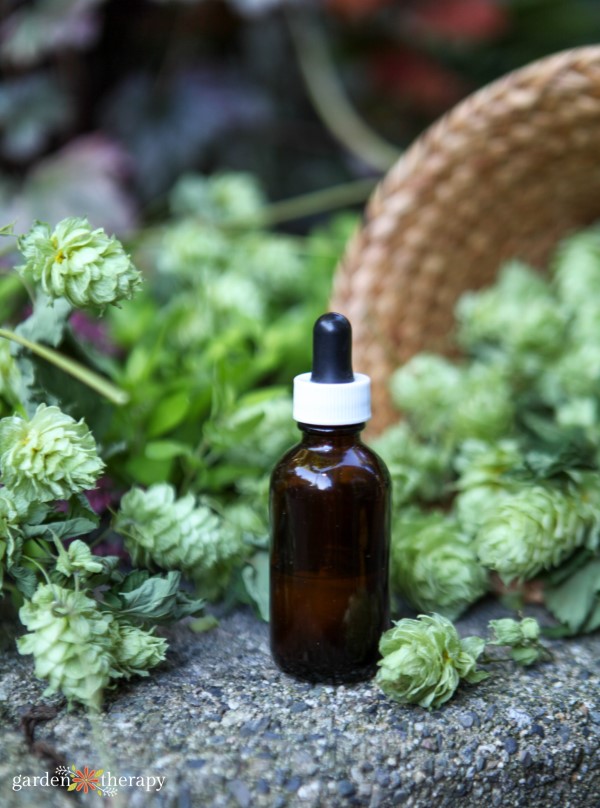

FAQ About the Hops Plant
Hops are ready for harvest in late summer, usually beginning in mid-August through to September. You want the brines to be fully ripe, as they will not ripen any more once picked.
Cut back a majority of the bines and unwind them from their trellis or structure. Leave behind 1-3 ft. of the bine, as this can help prevent crown damage. The plant will remain insulated and fed.
Hops are native to North America, Europe, and Asia. Only the perennial hops, Humulus lupulus, is native to North America. The Asian annual, Humulus japnicus, is a naturalized weed found in eastern North America, though it is not native.
Yes, hops are poisonous to dogs. They can cause severe symptoms and dogs who ingest hops should seek a vet’s attention immediately.
More Herbal Growing Guides


